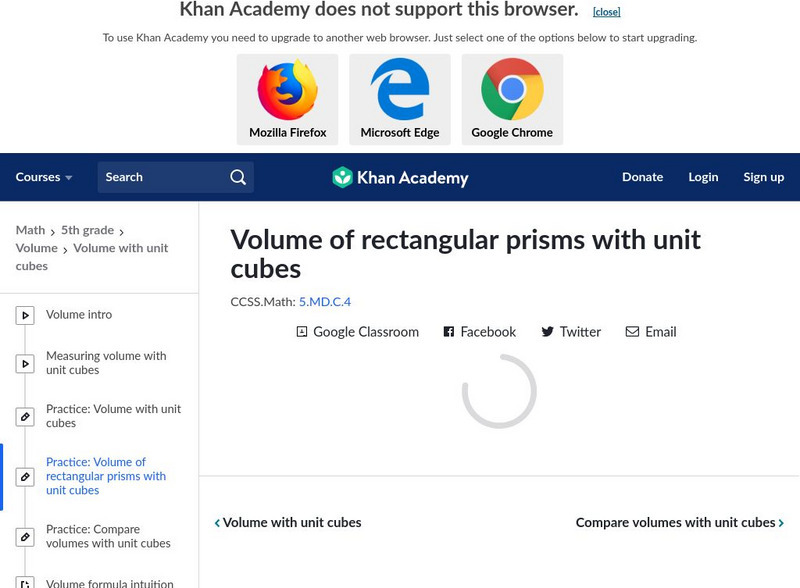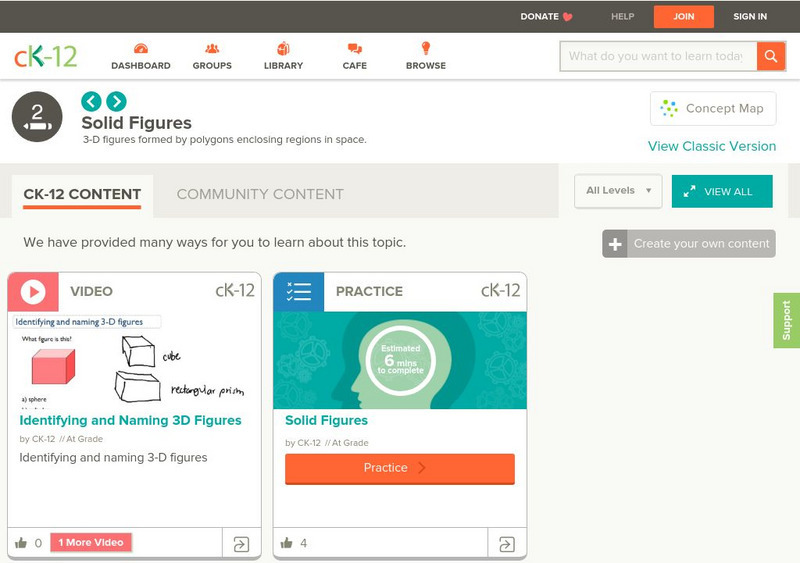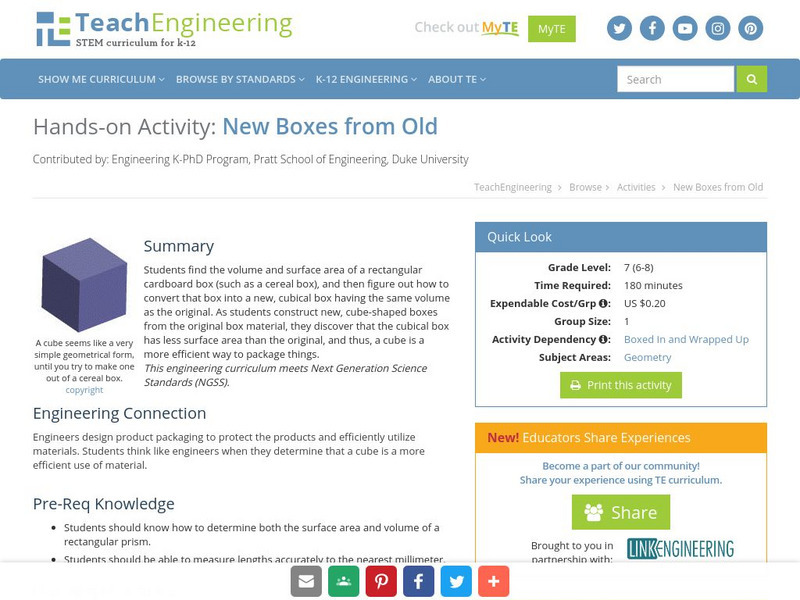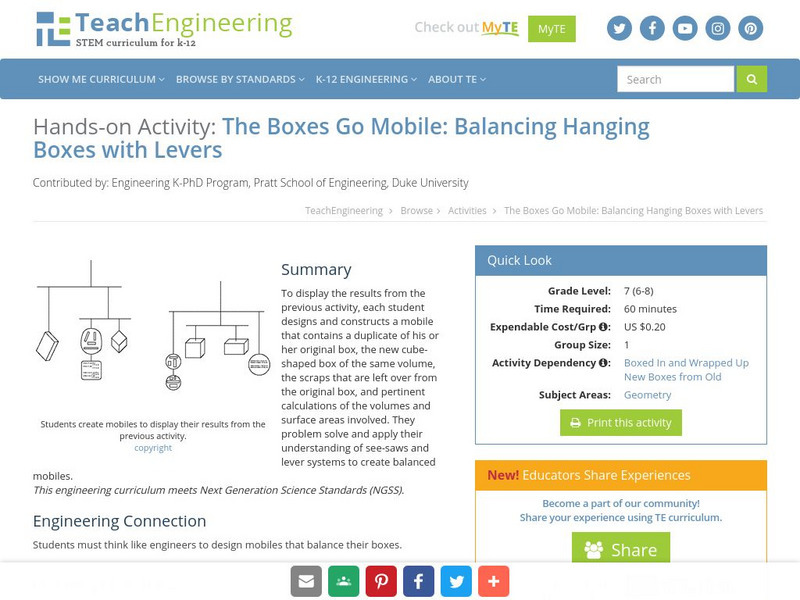Hi, what do you want to do?
PBS
Pbs: Volume of Right Rectangular Prisms
Learn how unit cubes can be used to model the solution for the volume of a 3D figure This video focuses on calculating the volume of a rectangular prism using the equation, length x width x height. This video was submitted through the...
University of Texas
Inside Mathematics: Cubes [Pdf]
This task challenges a student to use knowledge of concepts of volume and its attributes to solve problems with rectangular prisms.
Other
West Contra Costa Usd: Volume: A Foundation in Unit Cubes [Pdf]
A very detailed lesson on determining the volume of rectangular prisms, teaching students how to derive the formula for volume, and to use it successfully. Plenty of examples, student work, and assessment options.
Khan Academy
Khan Academy: Volume of Rectangular Prisms With Unit Cubes
Find volume of 3-dimensional figures by counting unit cubes. Students receive immediate feedback and have the opportunity to try questions repeatedly, watch a video or receive hints.
Khan Academy
Khan Academy: Decompose Figures to Find Volume (Unit Cubes)
Find the volume of irregular 3D figures made up of unit cubes by dividing the figures into rectangular prisms and finding the volume of each part. Students receive immediate feedback and have the opportunity to try questions repeatedly,...
TeachEngineering
Teach Engineering: Boxed in and Wrapped Up
Middle schoolers find the volume and surface area of a rectangular box (e.g., a cereal box), and then figure out how to convert that box into a new, cubical box having the same volume as the original. As they construct the new,...
Khan Academy
Khan Academy: Volume With Cubes With Fraction Lengths
Find volume of rectangular prisms by using cubes with fraction side lengths. Students receive immediate feedback and have the opportunity to try questions repeatedly, watch a video or receive hints.
Other
Calculator.net: Volume Calculator
Use these calculator tools to find the volume, in your choice of units, of a sphere, cone, cube, cylinder, rectangular prism, capsule, ball cap, conical frustum, ellipsoid, or square pyramid. Includes a reference section listing formulas...
Other
Calculator.net: Surface Area Calculator
Use these calculator tools to find the surface area, in your choice of units, of a sphere, cone, cube, cylinder, rectangular prism, capsule, ball cap, conical frustum, ellipsoid, or square pyramid. Includes a reference section listing...
CK-12 Foundation
Ck 12: Elem Math: Identifying and Naming 3 D Figures
[Free Registration/Login may be required to access all resource tools.] Students watch a video and attempt practice problems on identifying and naming three dimensional figures.
Louisiana Department of Education
Louisiana Doe: Louisiana Believes: Eureka Math Parent Guide: Area, Surface Area, and Volume Problems
A guide to support parents as they work with their students with area, surface area, and volume problems.
CK-12 Foundation
Ck 12: Elem Math: Identifying and Naming 3 D Figures
[Free Registration/Login may be required to access all resource tools.] The video briefly shows and describes a cube, rectangular prism, triangular prism, and a cylinder and then determines what 3D figure is shown through process of...
Calculator Soup
Calculator Soup: Cube Calculator
Use this calculator to calculate unknown variables for a cube such as a side length, face diagonal, solid diagonal, surface area, and volume.
Calculator Soup
Calculator Soup: Surface Area Calculator
Online calculator to calculate the surface area of geometric solids including a capsule, cone, frustum, cube, cylinder, hemisphere, pyramid, rectangular prism, sphere, spherical cap, and triangular prism
Calculator Soup
Calculator Soup: Volume Calculator
Use this online calculator to calculate the volume of geometric solids including a capsule, cone, frustum, cube, cylinder, hemisphere, pyramid, rectangular prism, sphere, and spherical cap.
Mr. Martini's Classroom
Mr. Martini's Classroom: Volume: Geometry Practice Solving Volumes
Students solve for the volume of three-dimensional figures such as cubes, prisms, and cylinders with these interactive flashcards.
History is Fun
Jan Brett: Geometric Solids Flashcards Pdf
Print out these colorfully illustrated PDF file pages to practice learning your basic three dimensional geometric solids. Fold them in half and one side shows the shape while the other side shows the shape with the correct name. Put them...
Calculator Soup
Calculator Soup: Geometric Shapes
This reference lists formulas for geometric shape measurements and offers links to online calculators.
TeachEngineering
Teach Engineering: New Boxes From Old
Students find the volume and surface area of a rectangular box (e.g., a cereal box), and then figure out how to convert that box into a new, cubical box having the same volume as the original. As they construct the new, cube-shaped box...
TeachEngineering
Teach Engineering: The Boxes Go Mobile
To display the results from the previous activity, each student designs and constructs a mobile that contains a duplicate of his or her original box, the new cube-shaped box of the same volume, the scraps that are left over from the...
National Council of Teachers of Mathematics
Nctm: Figure This: Keeping Cool
Is it better to by block ice or crushed ice? Use your logical reasoning and measurement skills to solve this challenge that compares surface area of block ice and the same block cut into three cubes. A one page activity from the NCTM...



















